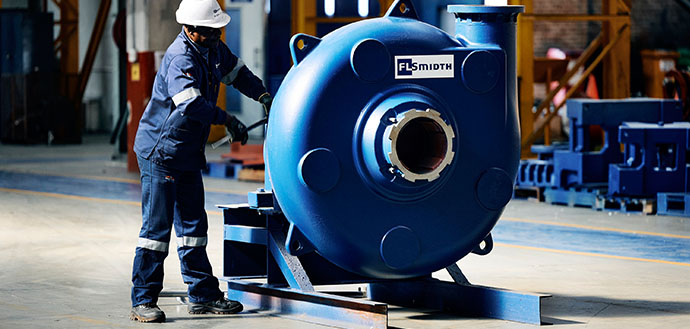GLOBAL minerals process specialist FLSmidth has allowed mines to achieve new levels of efficiency with the initially patented wear ring technology on its KREBS pumps, according to Stephan Kruger, FLSmidth’s Vice President Pumps, Cyclones and Valves for Sub-Saharan Africa, Middle East and South Asia.
“It is not only the rising cost of electricity that drives mines’ energy strategies, but also their commitment to a low carbon future,” he says. “FLSmidth’s KREBS pumps directly support these efforts by our mining customers, thanks in great part to our innovative wear ring technology.”
He highlights that two key aspects that reduce efficiency in slurry pumps tend to be suction side recirculation and mechanical grinding between the casing and the impeller. The wear ring significantly reduces both of these factors, leading to lower power draw and longer pump life.
“Through our case studies, we have seen power draw being cut by 5 to 10% for the same flow and head with the application of KREBS pumps,” he points out. “Similarly, we have measured the impact on pump life, and have shown that the life of wet end parts can be lengthened by one and a half to two times.”
According to Derek Lane, General Manager Operations, conventional products in the market solve only one of these factors through impeller and liner adjustment which may reduce recirculation but simultaneously exacerbates the grinding. “This leaves the pump user having to compromise on efficiency, which we do not expect our customers to do,” Lane explains.
He says adjusting the wear ring allows the speed of the pump to be maintained as a constant, rather than users having to speed up the pump in response to the impact of grinding and wear. The wear ring in KREBS pumps can be easily adjusted so that it continues drawing the same power for the required pressure, holding energy consumption to a minimum.
The regular adjustment of KREBS pumps can also be done without shutting down the pump and disrupting operations. The wear ring can be simply adjusted by hand while the pump is running, and without the use of any special tools, allowing the gaps to be kept as small as possible to avoid recirculation inside the pump, while maintaining speed and pressure.
The life of KREBS pumps is further enhanced by the range of materials of construction available to suit the application, says Kruger. “The choice of material is based on the application requirements and in particular minimising wear. There are a number of factors considered which determine the material of construction such as pump size, impeller size and tip speed as well as slurry hardness.”.
Materials used in the construction of slurry pumps are classified into two main types: metals and elastomers. For metal pumps high-chrome alloys, hypereutectic alloys, hypoeutectic alloys and stainless steels are commonly used. Elastomers options vary between natural rubber, polyurethane and synthetics such as neoprene.
He emphasises that the application of these materials makes their own contribution to the mining sector’s sustainability agenda, by reducing the level of scrap produced due to equipment replacement.


